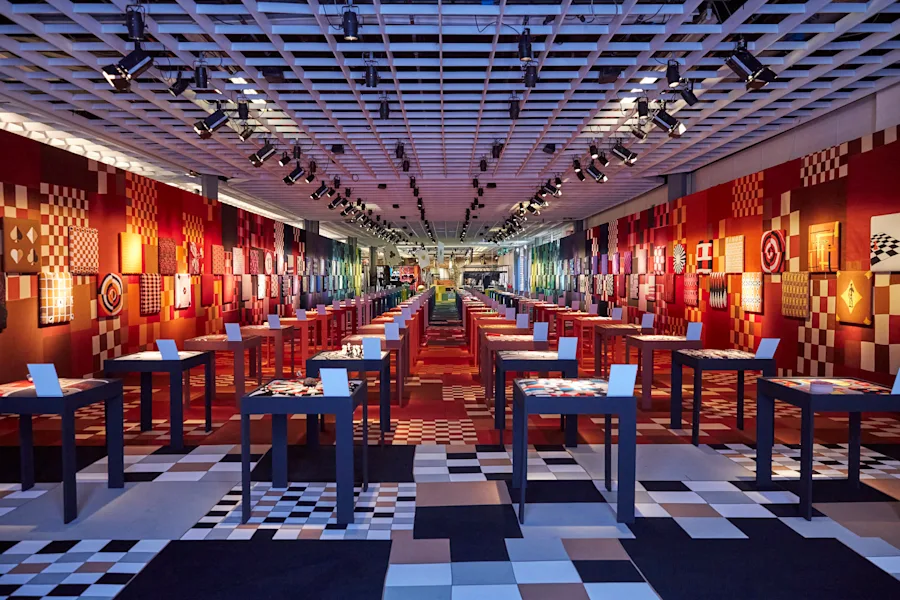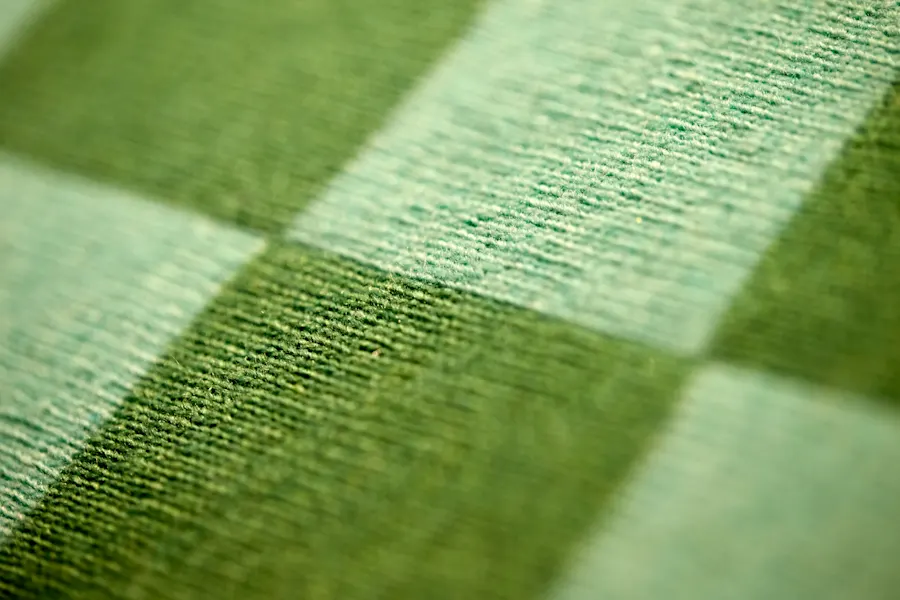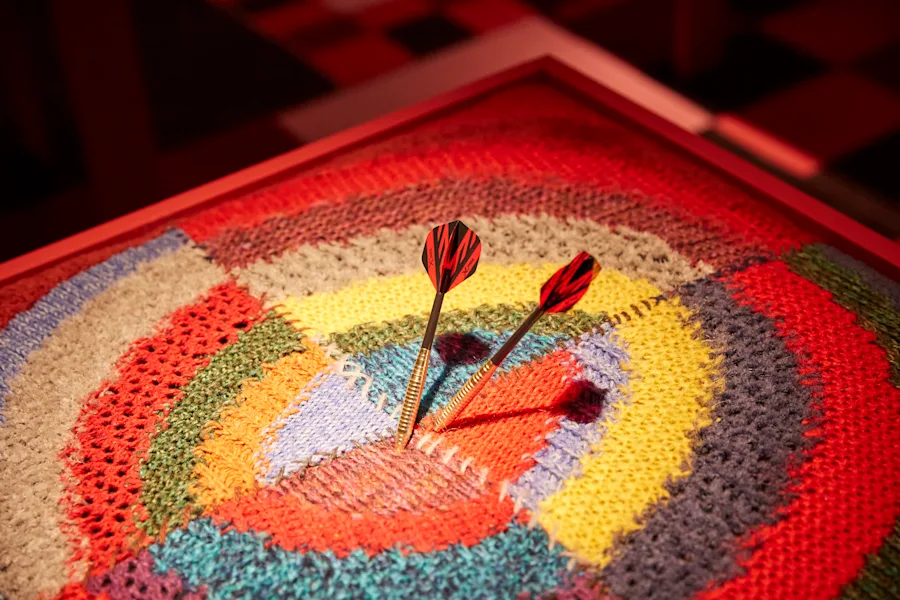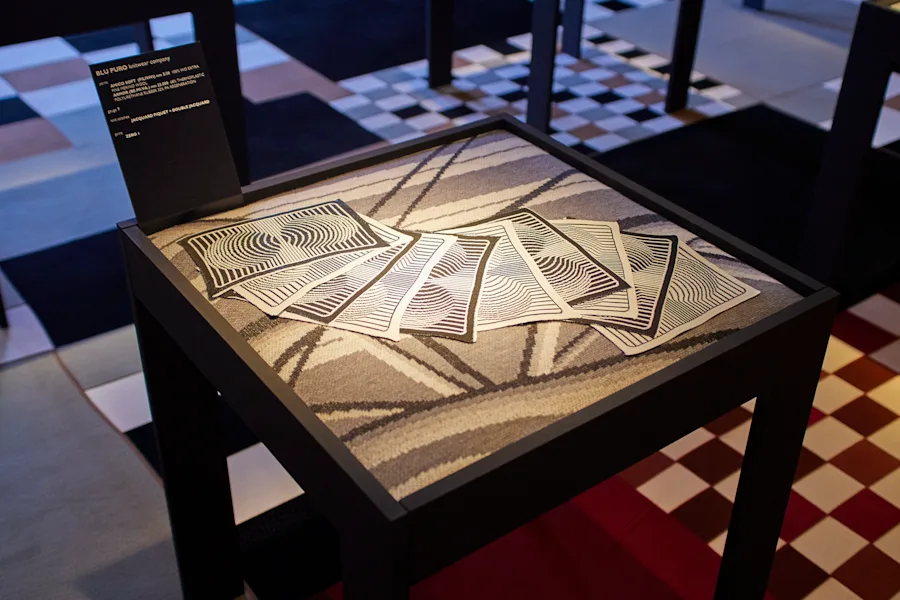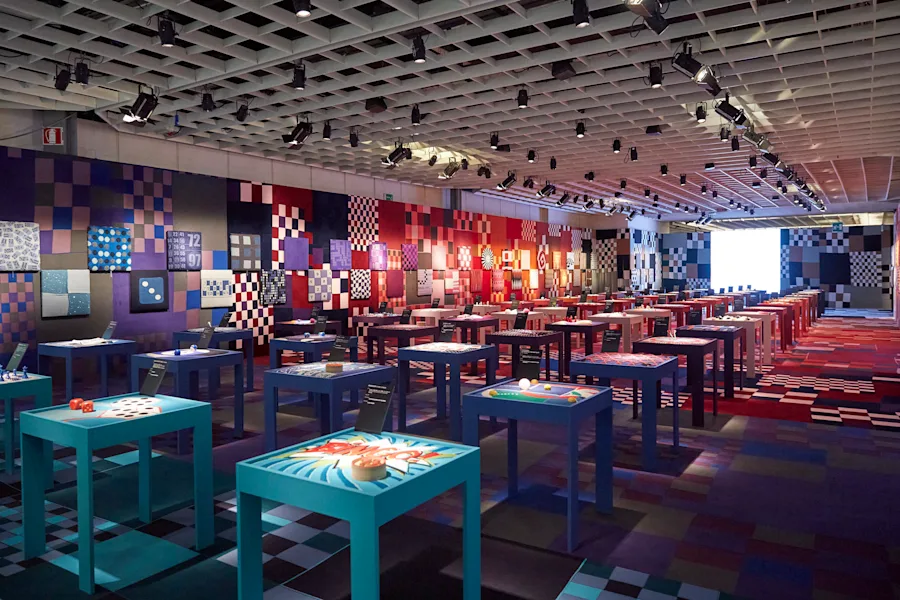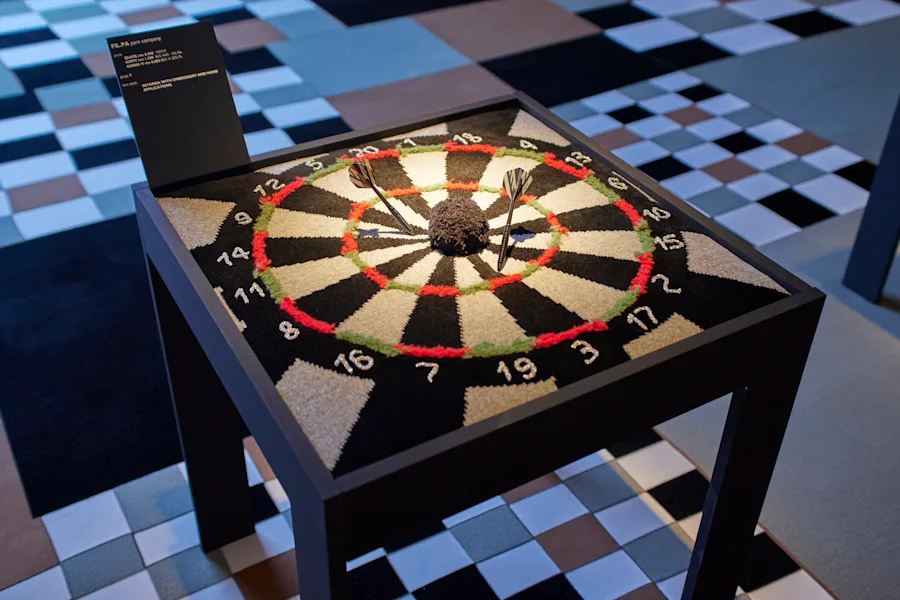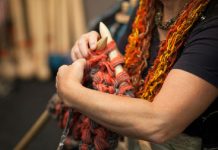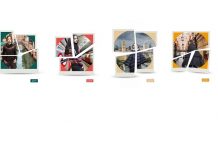Florence
The AW24/25 season at Pitti Imagine Filati 93 was a celebration of new talent, tradition and innovation.
Colour
The colour palette for AW24/25 featured lime green, aqua and bright cyan blending to deep purple. Charcoal, tan, brown and muted mustard provided an injection of neutral tones. Acidic yellow punctuated the blend of citrus orange, rust toned red and petal pink. From here, the colour palette side stepped into territory seemingly inspired by a spring countryside, with hedgerow and grass greens alongside sky blue gradients. Throughout the stands earthy tones of denim blues, indigos, brown and oranges were prevalent too.
Across spinners, a shade making a ‘come back’ was orange, ranging from pale peaches to bright and even fluorescent tones. Knoll Yarns presented their new offerings catering to this colour palette, with shades ‘Selective Yellow’, ‘Tamarin’ and ‘Ruby’ introduced to their 2/17 Merino Lambswool range. Shades ‘Mikado’ (yellow), ‘Baltimore’ (red) and ‘Lava’ (orange) were added to their Supersoft 100% Pure New Wool 1ply and 2ply range.
Stitch
The title for the AW24/25 season research area ‘Domino’ described a sense of ‘energy, openness, strategy, luck, thought, daring and chance’. Swatches responded to the theme playfully, literally interpreting the idea of playing games and facilitating relaxation to take well-contemplated risks. Knitted interpretations of darts boards, chess boards, billiards and board games were showcased, incorporating many mixed media processes.
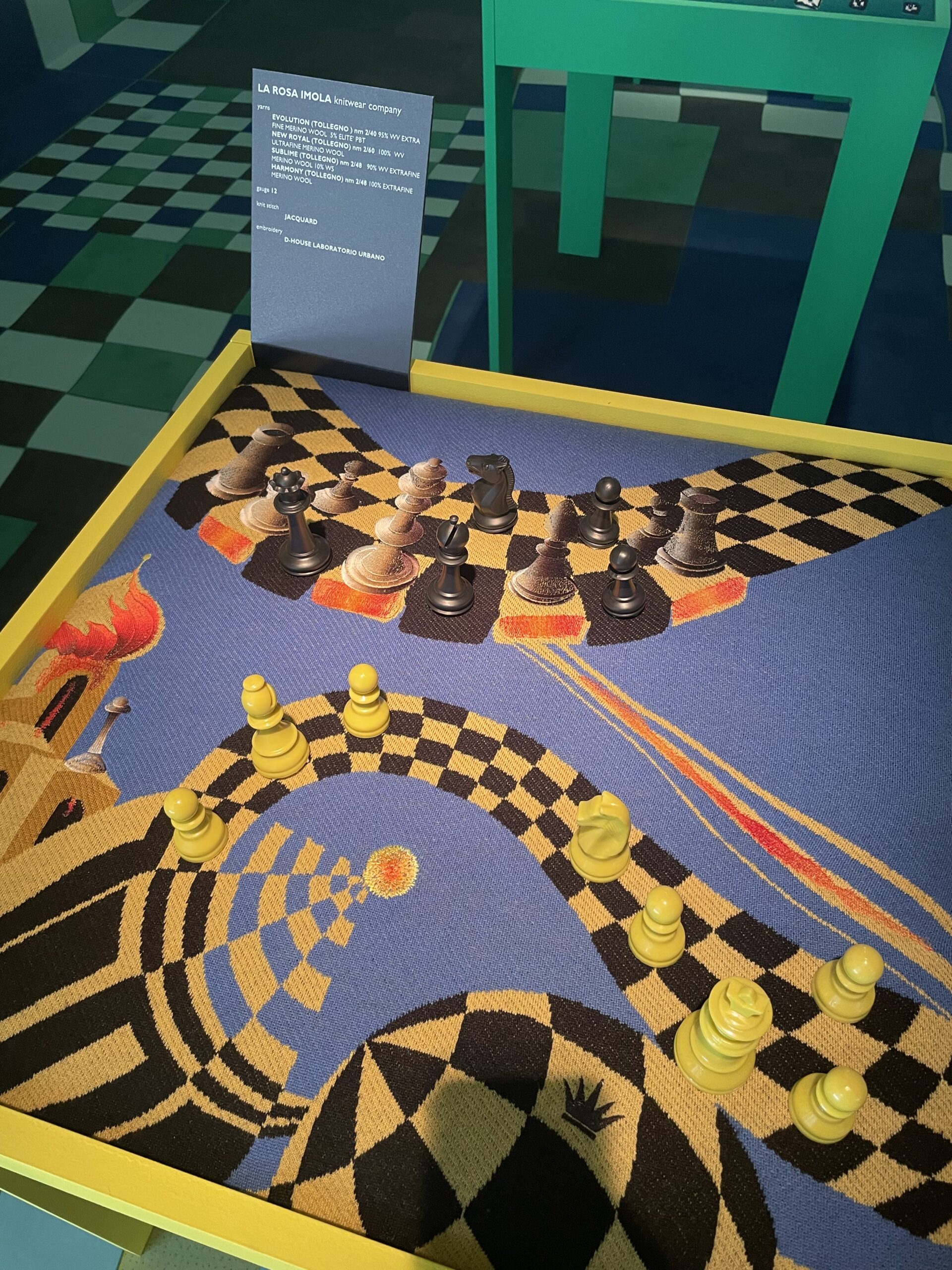
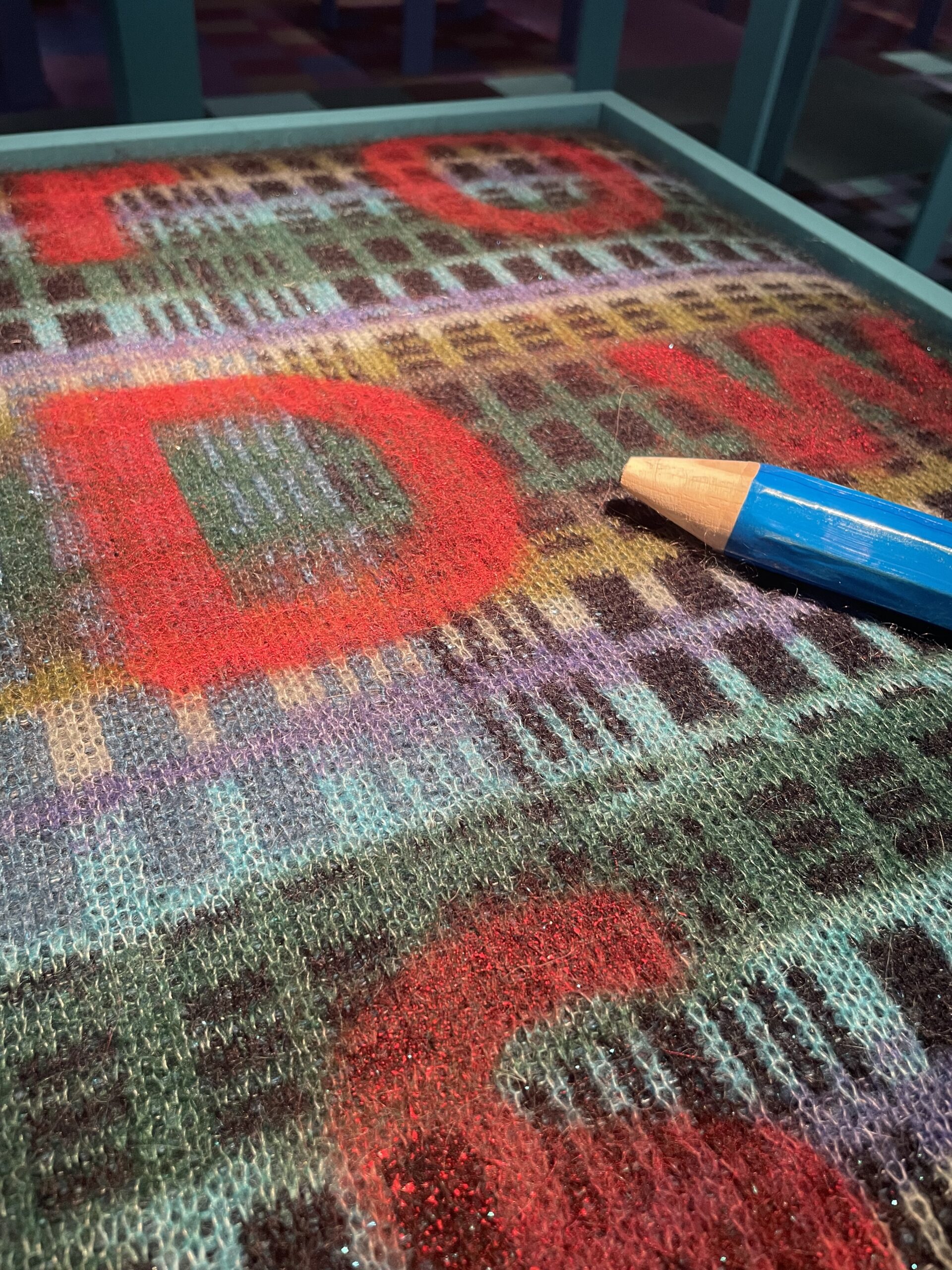
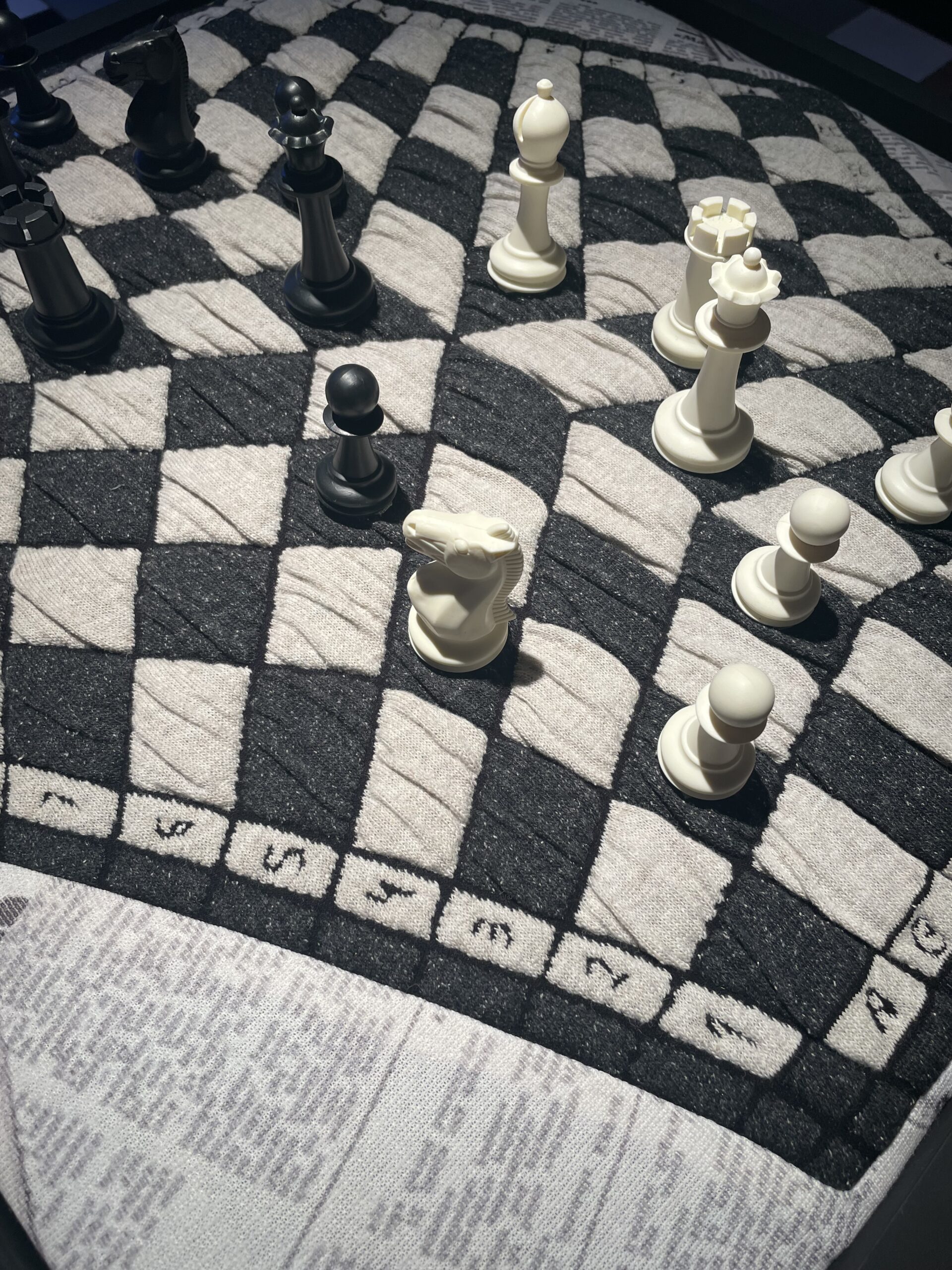
In keeping with the spirit of risk taking, post-machine processes were explored in unique ways, generating interactive, tactile knitted surfaces. Multi stitch intarsias were combined with hand crafts of 3D embroidery and crochet. Spray painted knits sat alongside digitally printed surfaces and laser cut felt. Thermal tape was utilised to create sharp, defined lines and illustrative designs were captured in a variety of jacquard structures. This felt like a real demonstration of the potential of knitting to be combined with mixed media processes.
Across the stands, swatches from spinners were less playful but the texture variations were still apparent as many swatches featured metallics, sequins and brushed mohair. Tonal textures were notable throughout, with tuck stitches and lace holes catalysts for varied opacities and layers. Fibre properties were utilised to create ombre effects with brushed colour blends from one shade to the next.
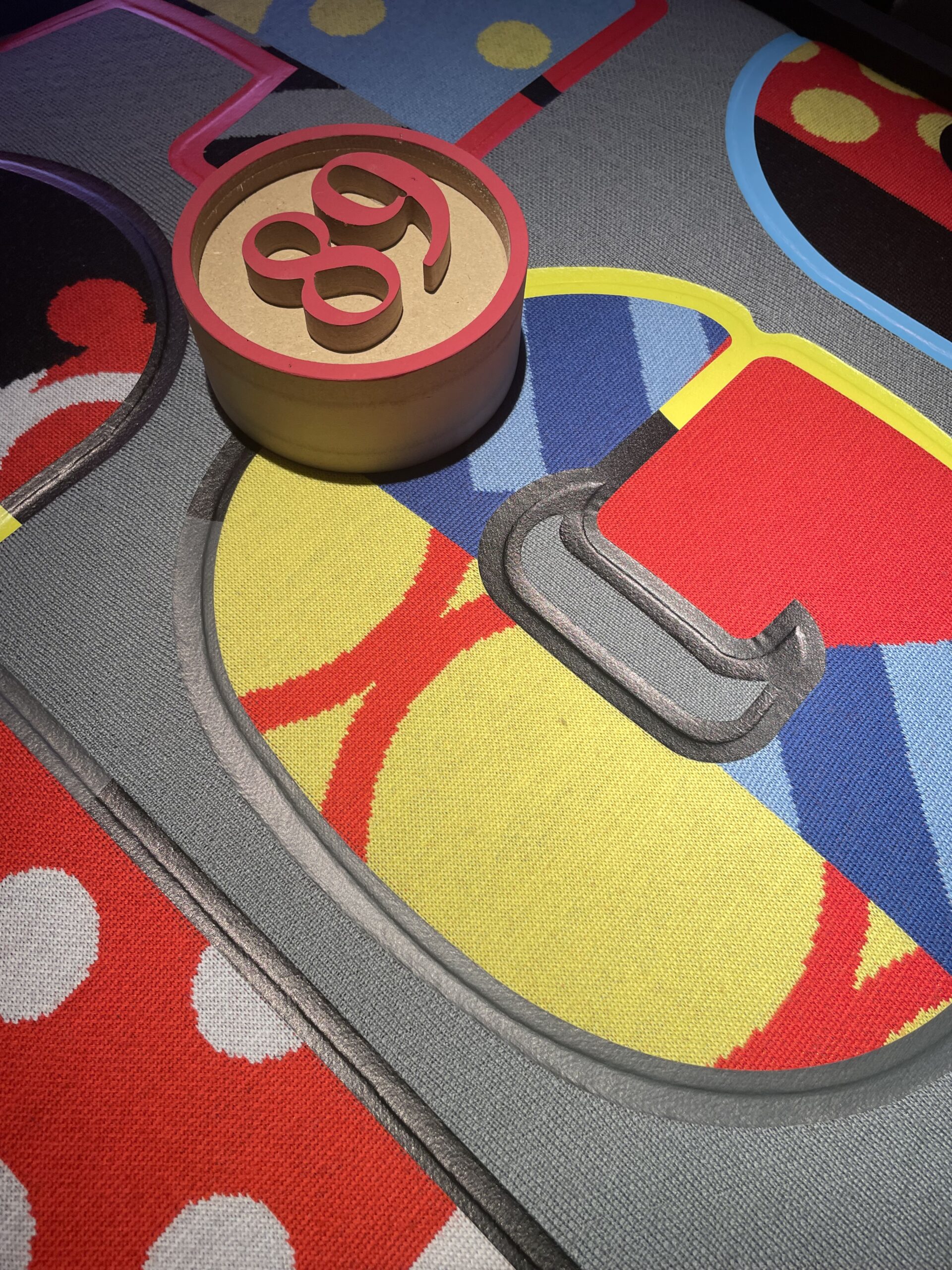


Collection Newness
Sesia
Relied upon for their diligent certifications across much of their collection, Sesia presented some exciting new offerings for AW24/25.
Sequins were prevalent, showcased in new qualities FESTIVAL (Nm 2.050, 78% Superfine Merino Wool, 18% Cashmere, 4% Polyamide, +6% Polyester Sequins) and RE-VIVAL, GRS certified (Nm 4.700, 90% GRS Polyester, 5% Polyamide, 5% Metallized Polyester, (+53% GRS Polyester Sequins). BOREALE was another new quality, (Nm 2.900, 74% Polyamide, 26% Baby Suri Alpaca, +25% Polyester Sequins).
Perhaps their most inspired new offering however was new quality ELVIS, (Nm 4.400, 100% Polyamide, +38% Polyester Sequins). This sequin fancy yarn has a colour gradient, blending from pastel hues to darker tones in each colour quality. This delicate effect is reminiscent of dip dye techniques, and the sequins add a truly special finish.
Alongside their sequin offerings, un-dyed wool and alpaca were also strong in their offering. Many of their animal fibres are also ‘Land To Market Certified’. In line with the prevailing trend for texture and tactility, their new qualities CINCILLÀ (Nm 5.500, 37% Mulberry Silk, 33% Polyamide, 30% GRS Polyamide) and MAXI SHEARLING (Nm 1.500, 92% Extra-fine Merino Wool, 8% Polyamide (PA) offer designers exciting textural opportunities.
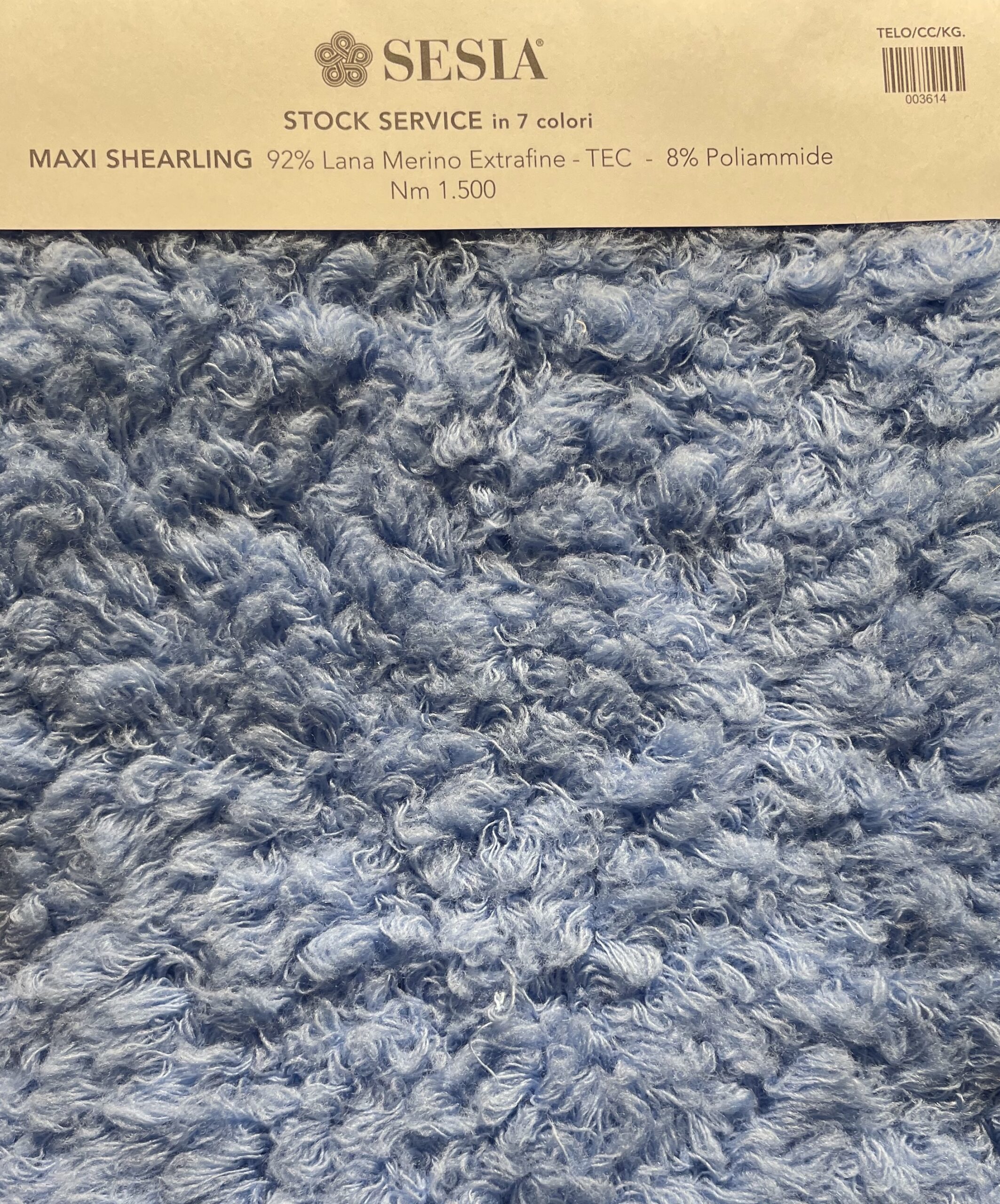
Shepley Yarns
Shepley Yarns presented their worsted spun yarns, showcasing their ever-popular colour selection. In 2022 they introduced their eye-catching fluorescent range, including ‘Fandango Pink’, ‘Zest Yellow’, ‘Lava Orange’ and ‘Nitro Green’. The colour potency of these shades really is impressive. These shades could work beautifully for knitted trims and tipping details as well as accents within woven fabrics too.
Colour trends are not a direct focus for Shepley, their aim is to provide designers with timeless, beautiful core shades that they can rely upon season after season.
Identifying gaps in their offering for AW23/24 they added in new shades for AW24/25 which include mélange shades ‘Fistral Blue’, ‘Orchard Plum’ and ‘August Peach’.
Particularly beneficial for domestic machine knitters, hand knitters and students, Shepley also supply many of their yarns in small quantity cones through sister brand ‘Wooly Knits’. This means small scale producers and students can experiment with high quality yarn in various shades without facing the barrier of order minimums and high costs. Colours available for stocks service reflect their core collection shade range.
Loro Piana
Displaying a range of pointelle stitches, fine and heavy gauge cables and textured, tonal jacquards, Loro Piana’s fabrics for AW24/25 were classic and tonal in a palette of neutral sands, oatmeal and browns.
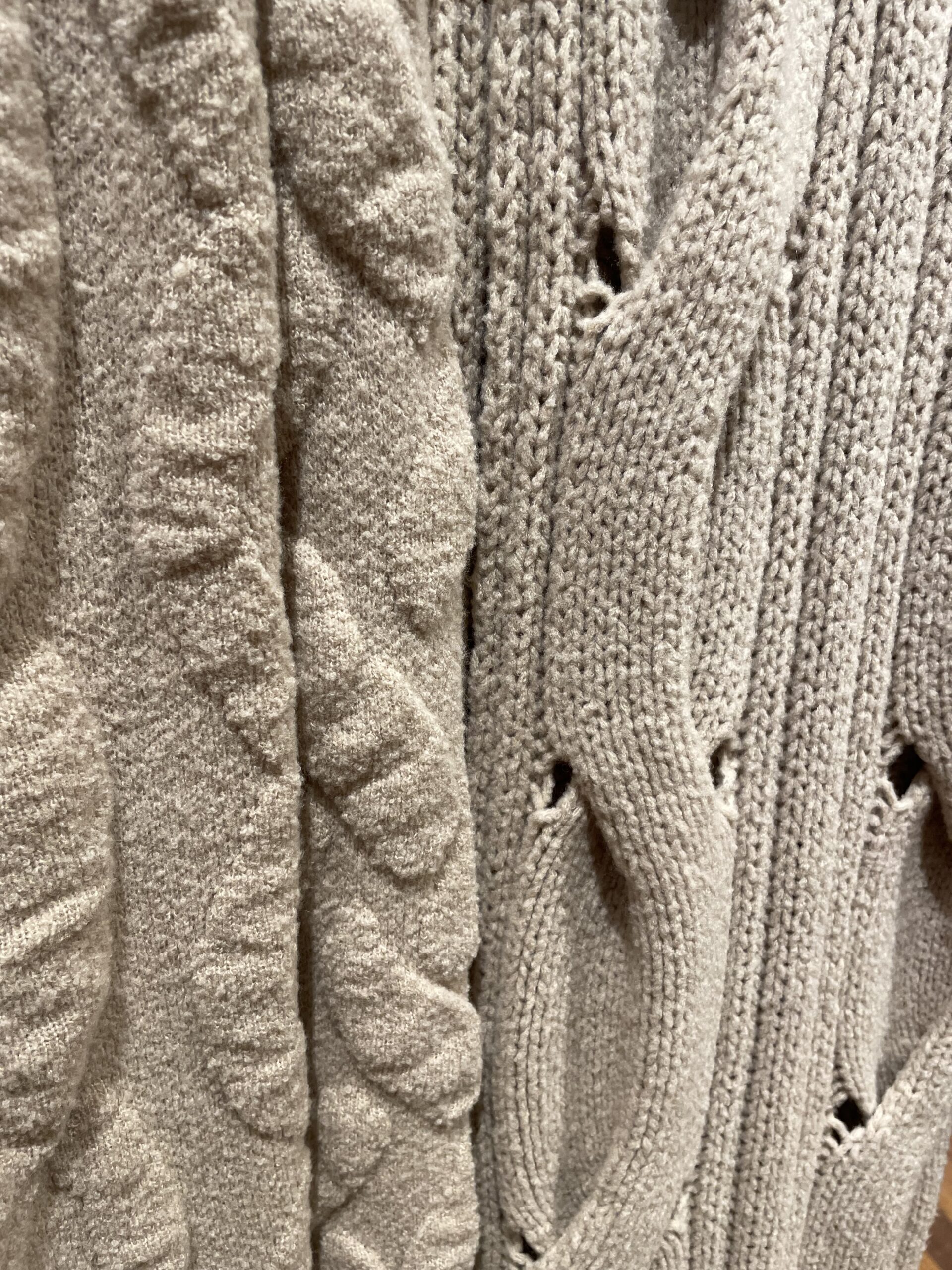
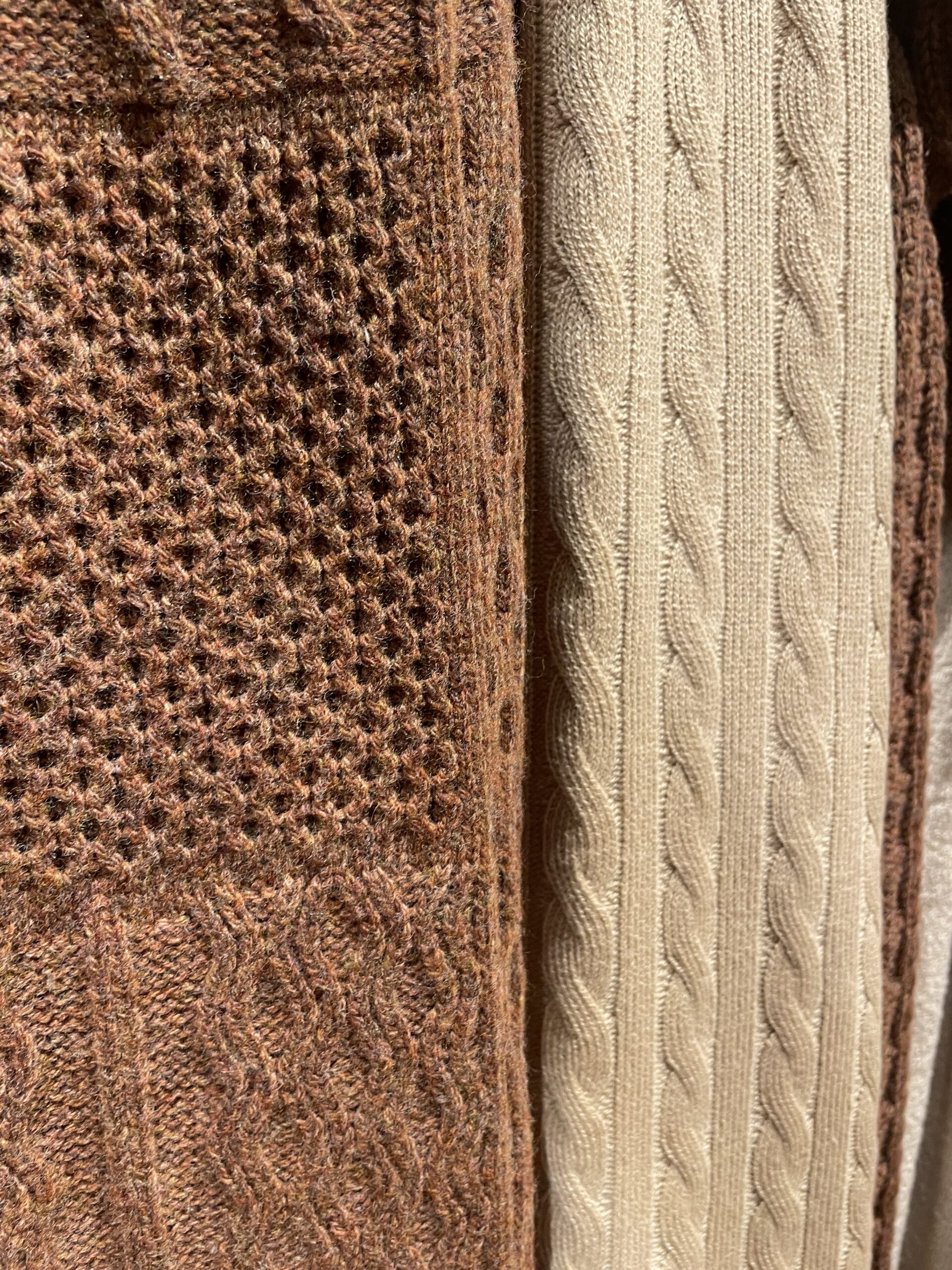
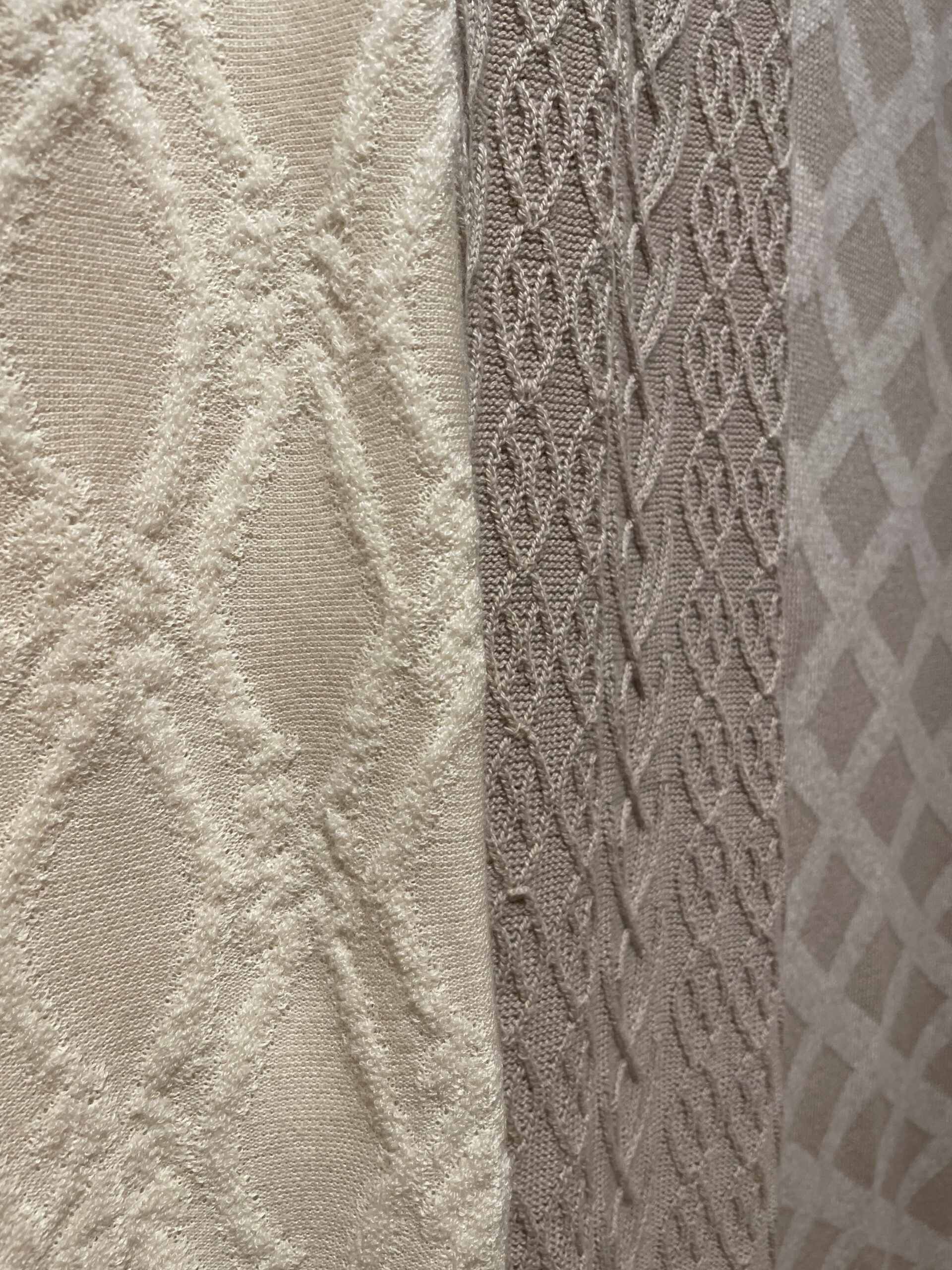
Displayed within their stand were the two winners of their seasonal ‘Knit Design Award’, celebrating talented students from leading institutions around the world. The brief was to use nature as an inspiration for reusing and reinventing Loro Piana yarns. The winners, both from State University of New York, were Sumin An with their knitted chair submission, and Blake DeWitt with their knitted jumper. Both submissions utilised colour in unexpected ways.
Sumin’s knitted chair/garment hybrid was a truly inspired idea, showcasing the potential Loro Piana yarns have to break moulds and revolutionise, as well as preserving tradition.
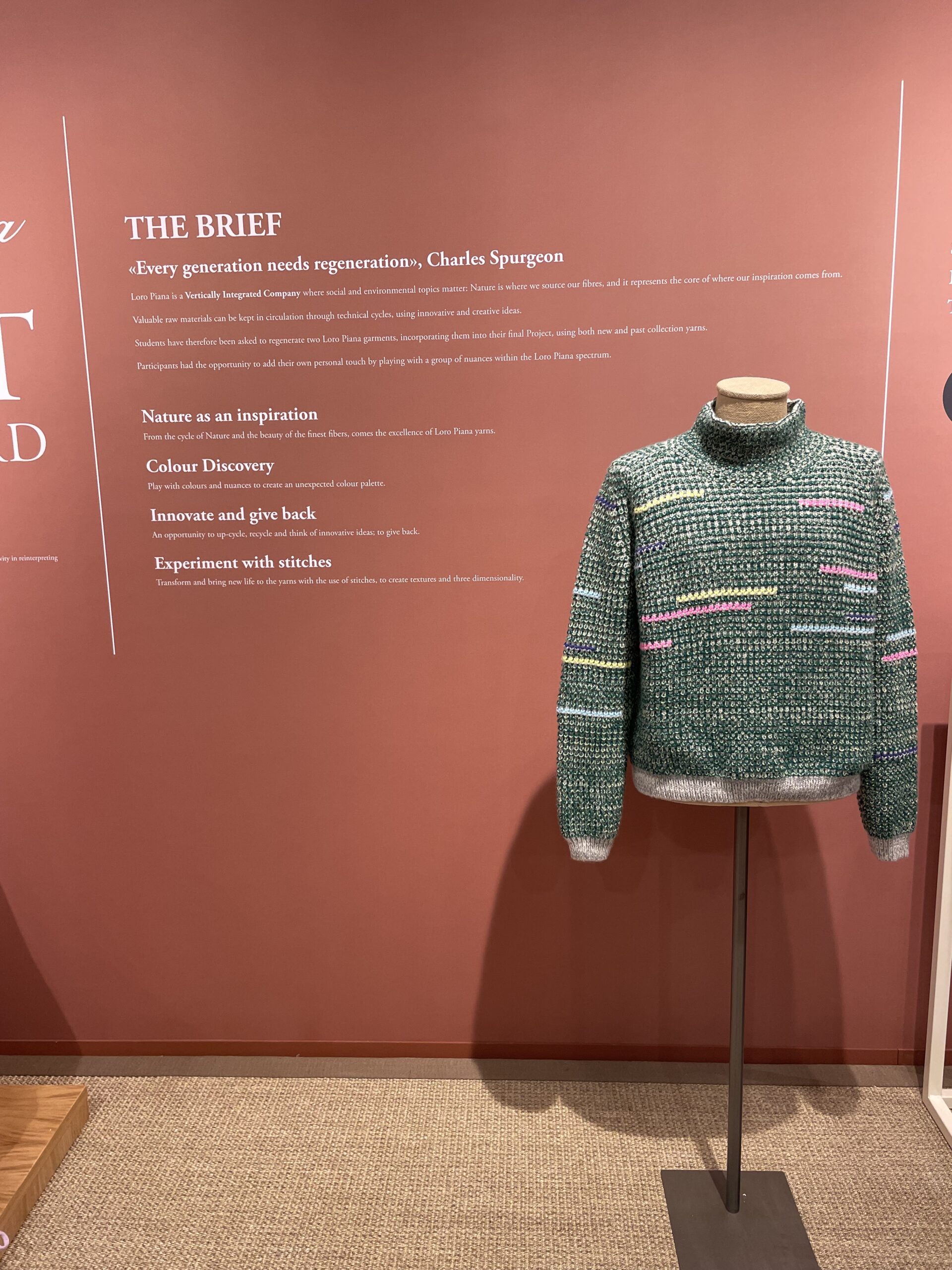

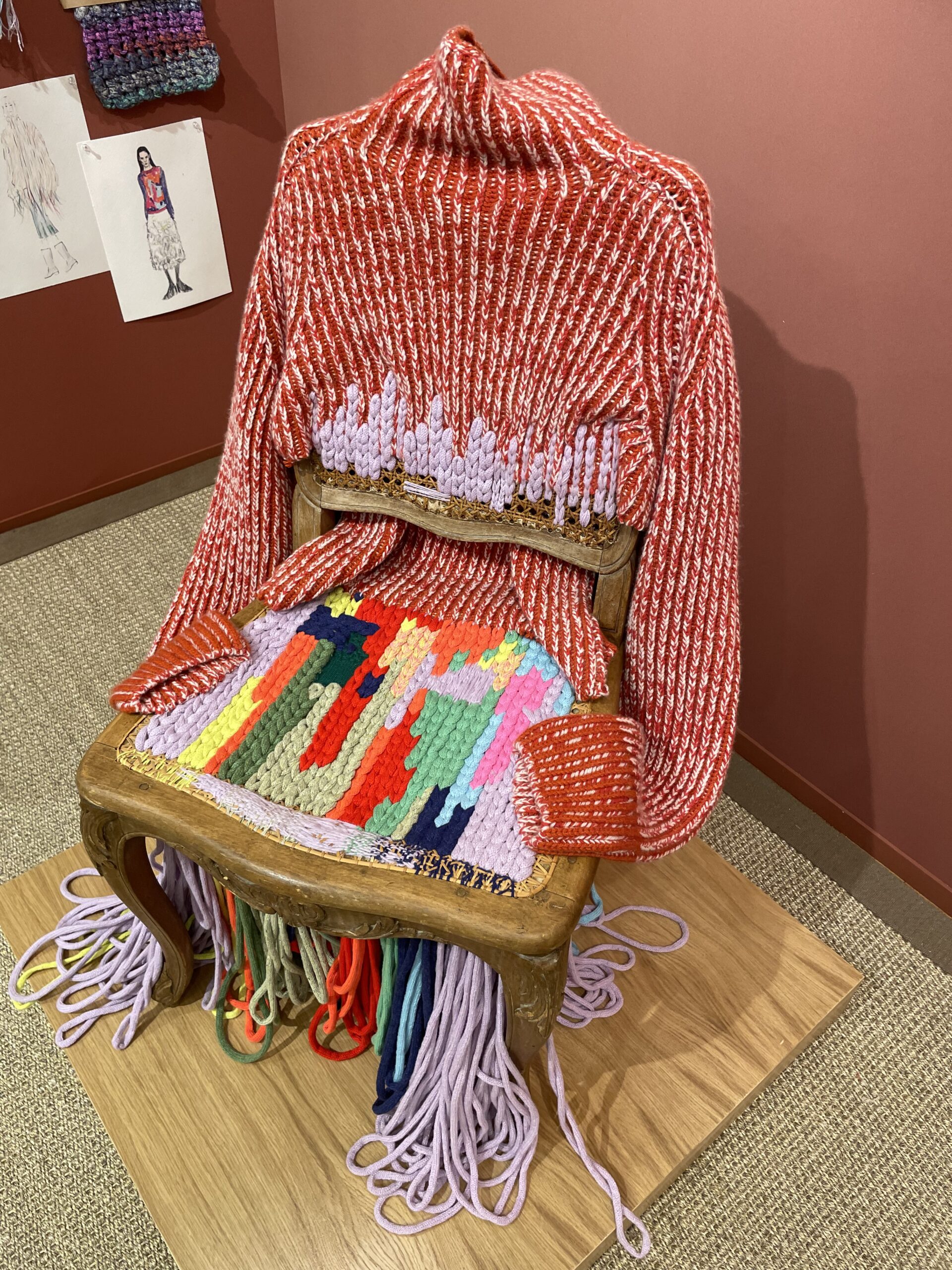
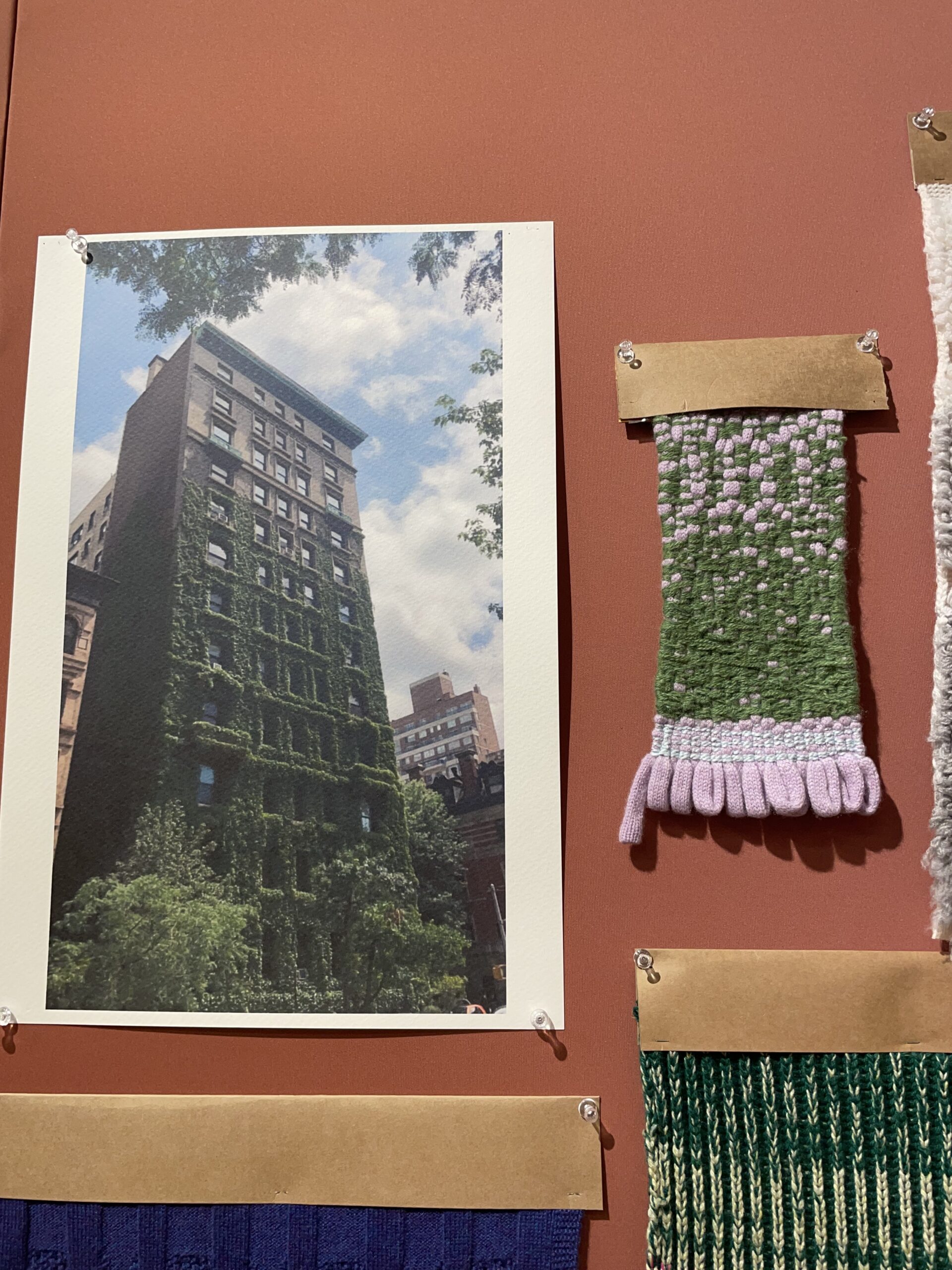
Lineapiu
Lineapiu’s collection focussed on its dedication to Japanese culture. Their project ‘Lineapiù Loves Japan’ aims to establish a dialogue with Japanese culture. The stand showcased contemporary reinterpretations of the traditional kimono, designed by students from the Bunka Fashion College in Tokyo.
Alongside these were their fabric swatches, presenting lofty handles and varied textures. Muted pastel rainbow shades blended from one to the next whilst lace holes and neutral shades created transparency and layers. Golds and metallics also had their place, with abstract multi fibre jacquards draped alongside tones of denim blues and indigos. Their palette echoed shades from varied landscapes, natural and muted yet enriched with the metallics and deep blues.
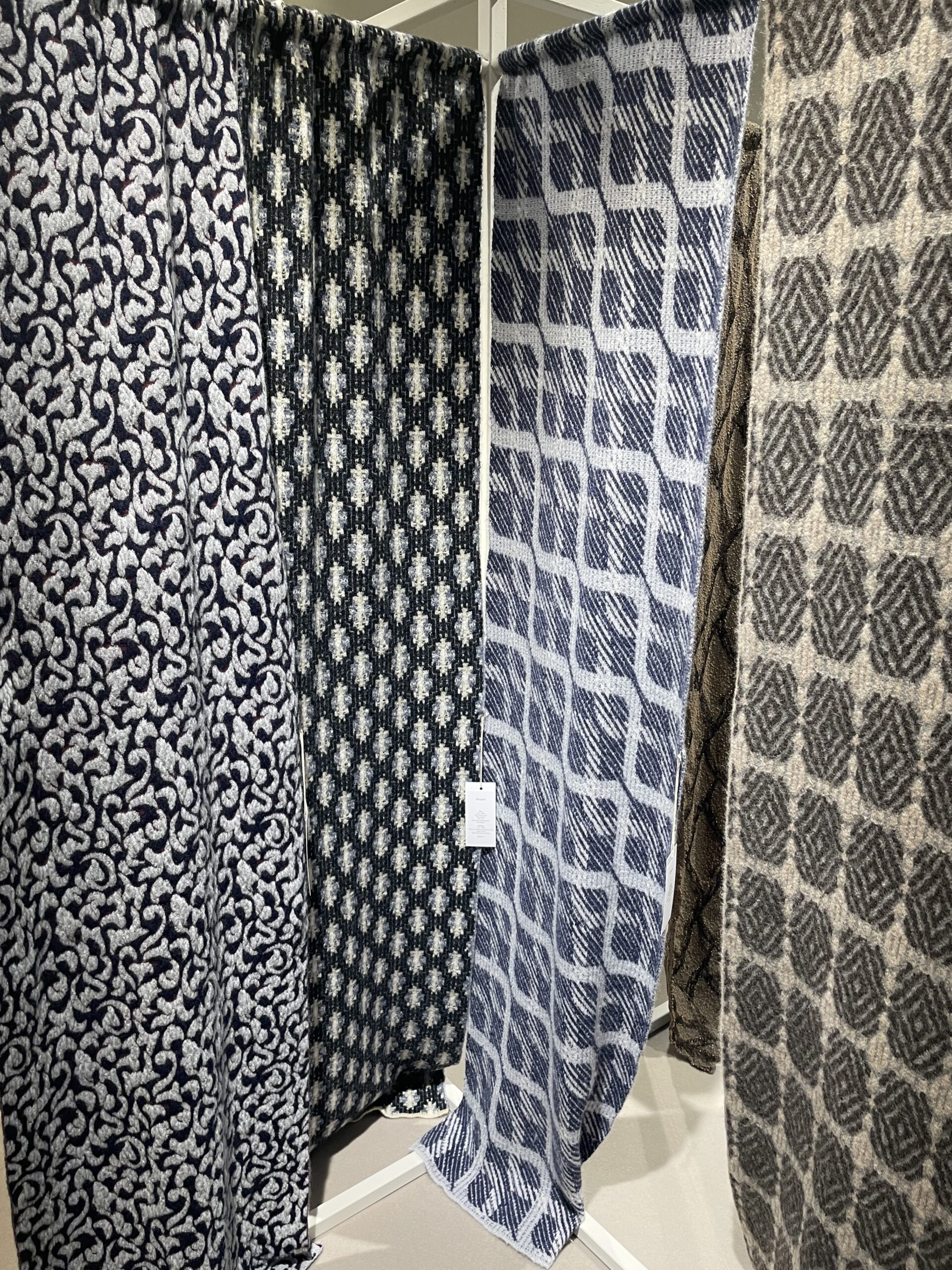
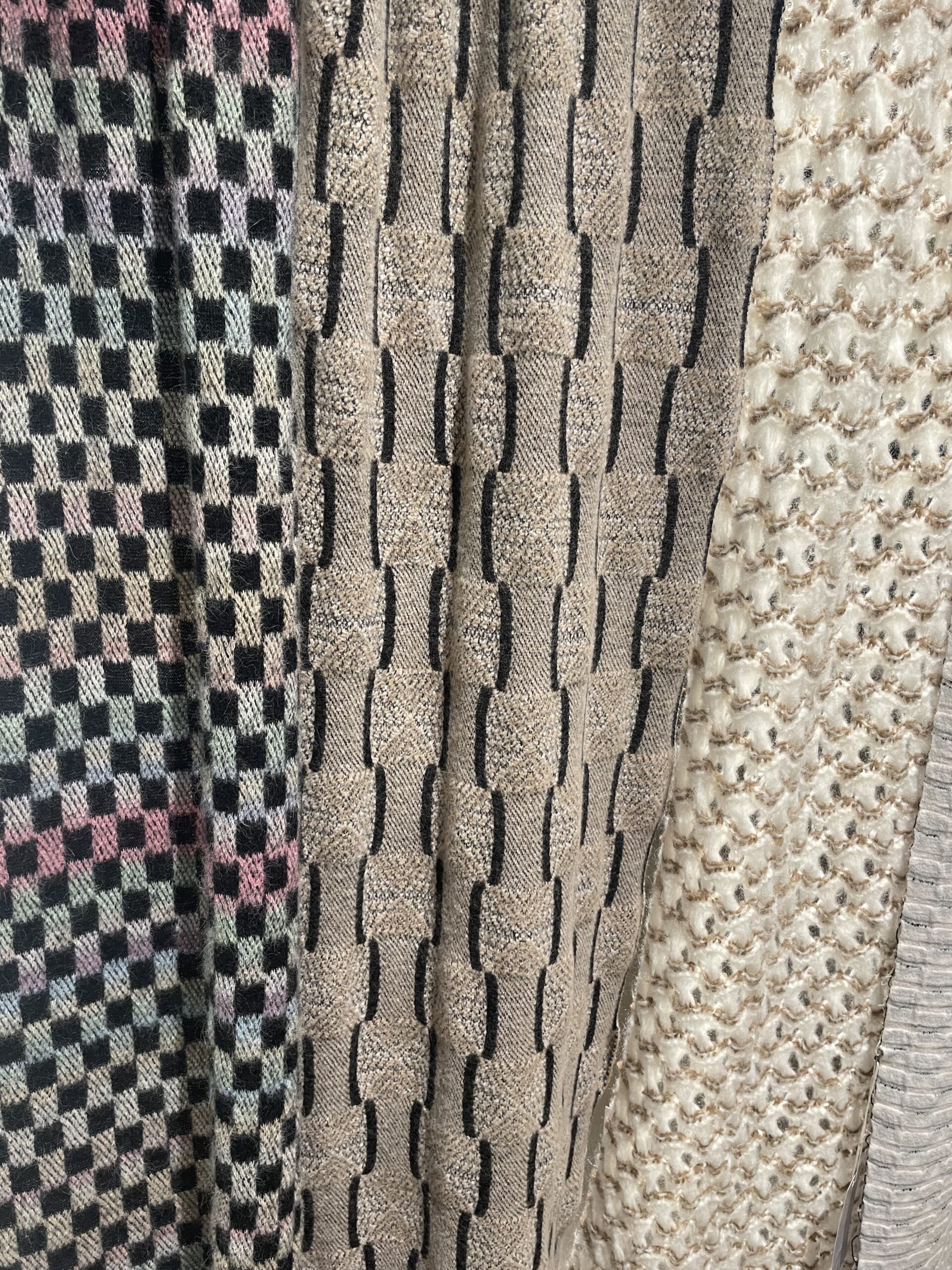
Biella by Sudwolle
Their AW24/25 offering is based on the theme ‘SPICE UP!’, celebrating cultural diversity and the universal appeal of spices. Their colour palette of orange hues was showcased in their garment presentation, enhanced by the technical stitches that demonstrated the versatility of their yarns- in particular their VICTORIA quality (Nm 2/30,100% extra-fine Merino wool, 19.5-micron, anti-shrinkage).
Biella embraced QR codes, with hang tags displayed alongside their garments inviting viewers to ‘find out the story behind the clothes’. Details behind their collaboration with Shima Seiki and MRC Knitwear-Research-Lab were revealed, sharing the inspiration behind this collection.

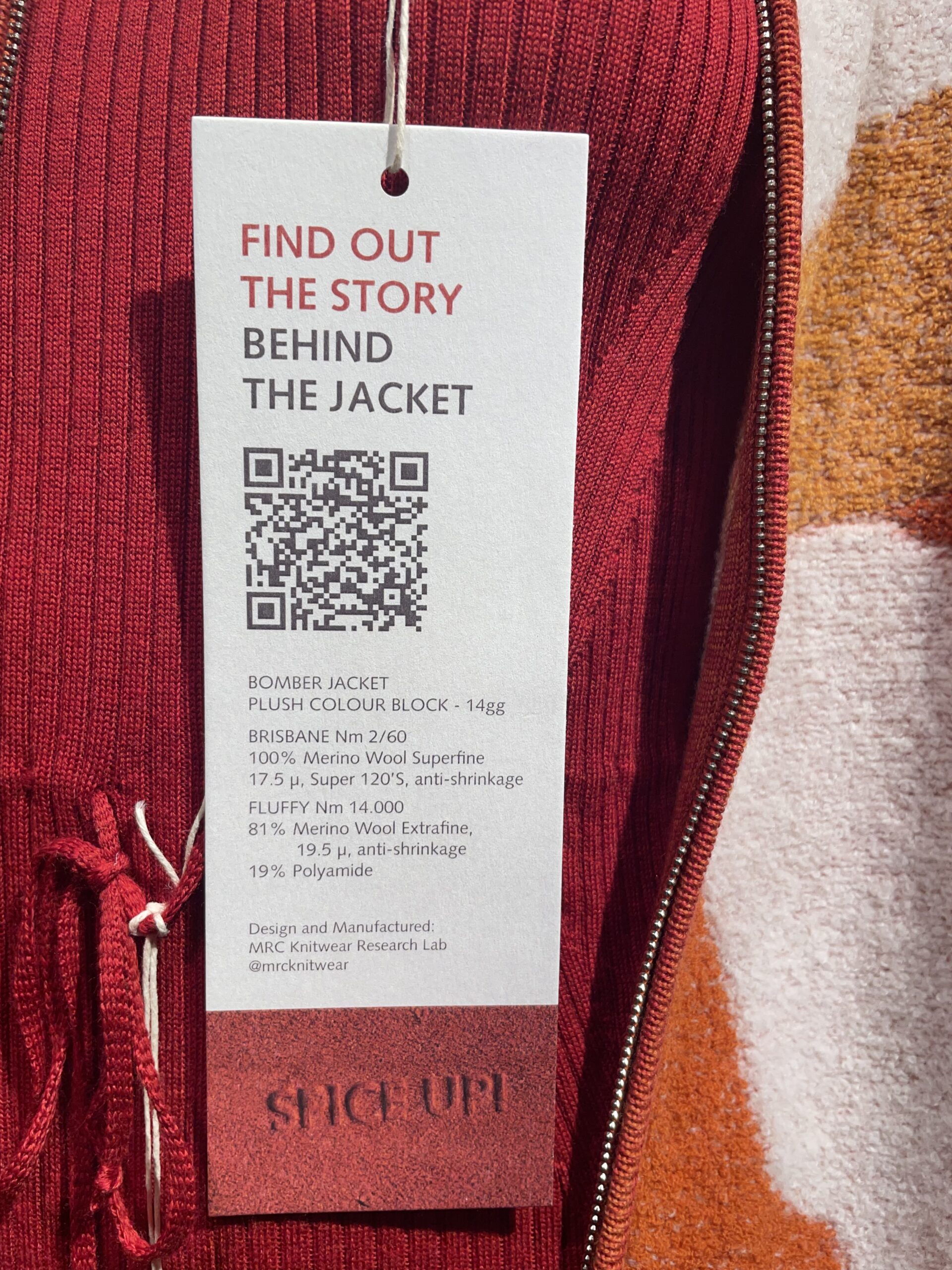
Gti Filati
Renowned for their unique worsted, fancy and carded yarns GTI is a particularly exciting spinner for craftspeople, hand knitters and crocheters, offering the finest selection of richly coloured yarns varying in weight and texture.
As the trend for brushed hairy yarns and fuzzy colour transitions shone through for AW24/25 season, GTI’s reliably sophisticated core collection offering really stood out. Many of their yarns are offered in brushed and non-brushed qualities such as their popular SELER Mulberry silk quality which is available as a chunky boucle, or a chunky brushed boucle. New quality offerings included WESLIE (2/5000NM, 100% Cashmere), WHOOPINO (2/4000NM, 100% Cashmere) and MACY (700NM 6% Mohair, 7% Silk, 87% Wool).
Whoopino 100% Cashmere was a particularly interesting new quality, with the hand feel of a super soft mulberry silk blend, and the glossy finish of silk too. As always, their shade card offerings across the collection are rich and luxurious, offering natural undyed shades as well.
A celebration of wool, yak and alpaca
Spinners were keen to showcase and highlight the properties of their traditional core yarns, particularly the technical properties of their wool and noble fibre blends. Natural blends and noble fibres with stringent certifications were being recognised and pushed to the forefront. Biella’s choice to use their 100% Merino Victoria quality for their seamless collaboration was a fine example of this.
The Woolmark Company
Within their WoolLab stand, Woolmark presented their trend stories for AW24/25. Compact jerseys sat alongside boiled wools and padded jerseys in their ‘Casualisation’ story. ‘Young Formalwear’ contained boiled wools and merino wool blends, whilst their ‘Sports Communities’ story presented light weight ribbed double jerseys and warp knit corduroy. Hand knitting was celebrated within their ‘Necessary Ornaments’ story, demonstrating the capabilities of wool specifically within accessory design. Biophilic Design was also explored, presenting Merino Wool and noble fibre blends as an interior design material to contribute to both inner and outer wellbeing, applied to honeycomb and waffle jerseys combined with seamless jersey.
Innovation
Relux, a Re.Verso Product had their stand alongside the spinners too. Relux is a newly certified fibre made by recovering wool and cashmere from production waste and post-consumer waste such as worn-out clothing. This provides a circular solution to minimise textile waste and extend the lifespan of natural fibres. Relux is made from 100% recycled noble fibre. Fabric swatches in a variety of weights, gauges and structures demonstrated the potential of this new innovation, presenting exciting potential for the future of noble fibre recycling. Certified by The Global Recycled Standard and consuming less water, CO2 and energy than virgin fibre production, Relux is a luxury fibre initiative to keep an eye on.
Shima Seiki Italia showcase WHOLEGARMENT Knit Performance in Wool
Shima Seiki Italia displayed their collaboration with the Woolmark Company and Loro Piana Yarns, utilising Macpi Group and H-Dry technology. There were two clothing looks, designed for the mountains and winter sports.
This collaboration aimed to express the value of sustainable yarn choices in combination with WholeGarment technology and innovative applications of wool fibres. Their 3D membrane performance jacket was displayed along-side a backpack and gloves embracing the same technology. Designer Vittorio Branchizio worked with Shima Seiki Italia’s expert technicians to create the outwear performance garments: “Most pieces in the collection are created with WholeGarment flat knit machines, with only one seam. With the latest technology and innovative applications for the wool fibre, including 3D membrane and bonding technology, the prototype collection utilises Merino wool for both technical performance and adventure.” (Woolmark Company).

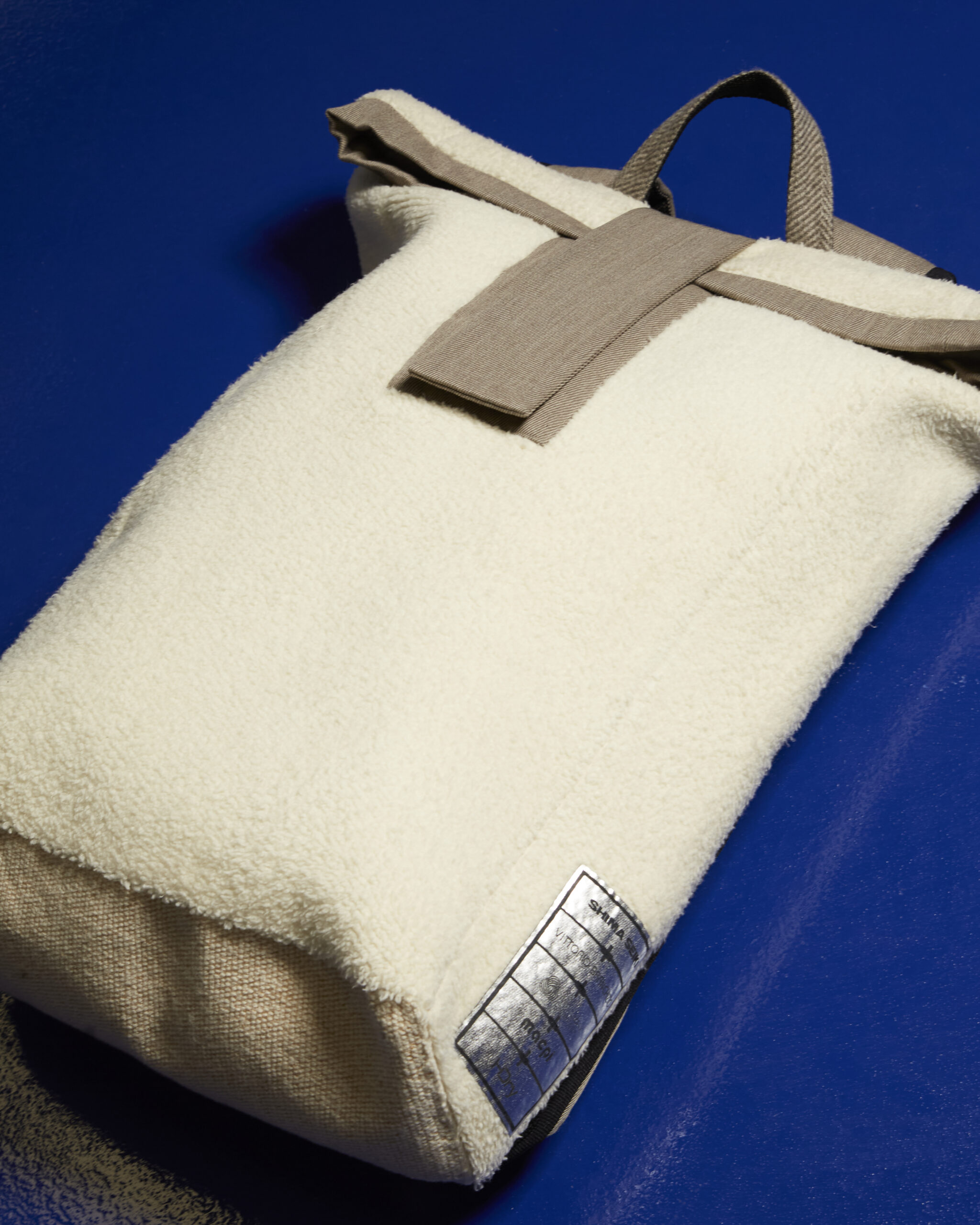
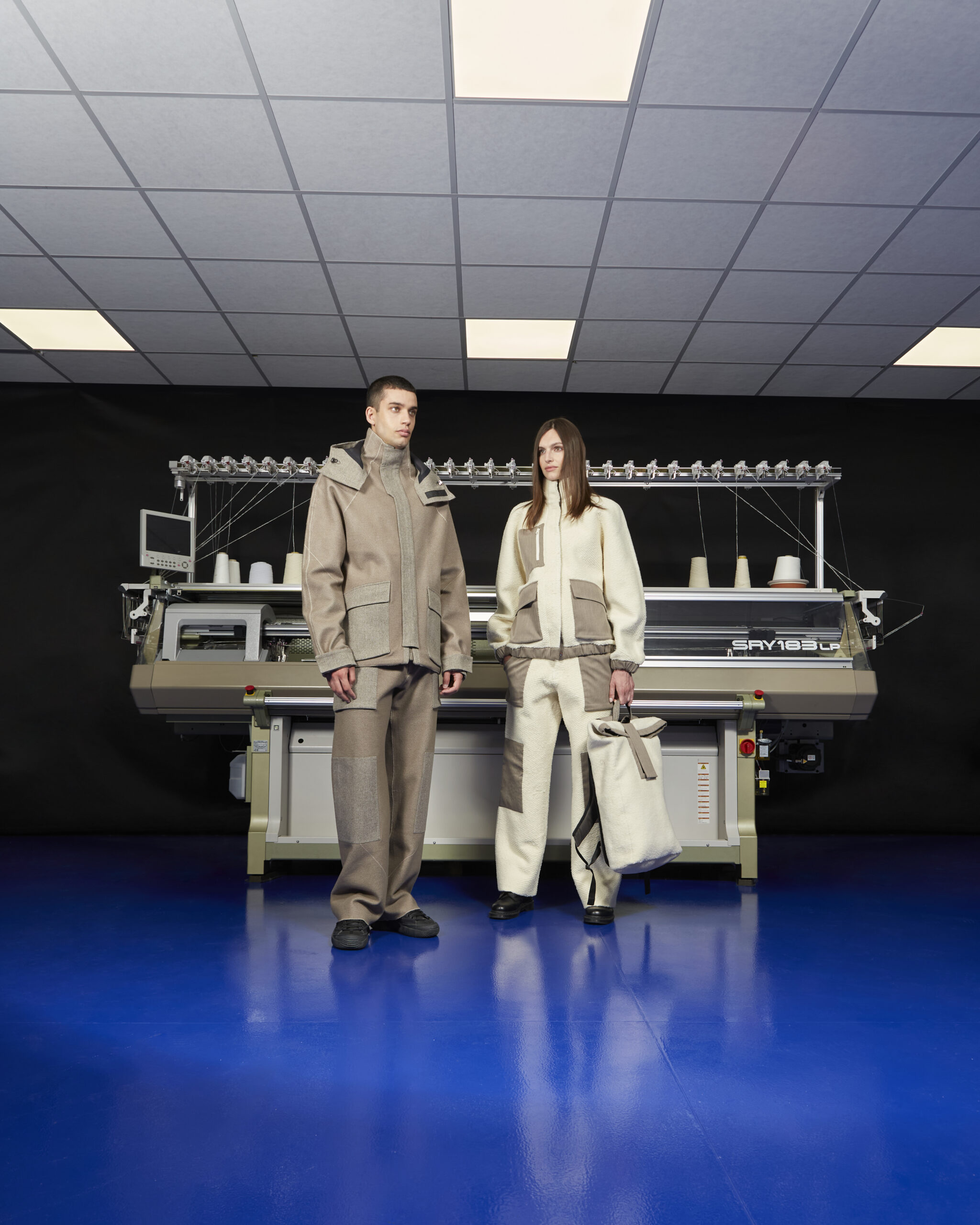
Traceability progress
Perhaps more impactful than the aesthetics presented at the show was the noticeable move towards supply chain transparency. But how so? Through the prevalent endorsement of QR codes across the stands.
A sense of environmental responsibility and caretaking had truly washed over the show as collection cards were scattered with certifications.
Utilised in a variety of ways, the majority of spinners invited visitors to scan QR codes for their garments and swatches, leading to web pages containing information about the fire sources, certifications, quality information and more.
Though this has arguably been a long time coming given the use of QR codes is hardly a new concept, the invitation to learn more about fibre production processes and certifications with such ease is warmly welcomed. Gone are the days of these conversations being an afterthought. Spinners were keen to celebrate and highlight the various certifications their yarns held.
It will indeed be interesting to see how brands who purchase from these spinners take responsibility for communicating these narratives to their consumers. With the effort now being made by many spinners, the onus lies within fashion brand marketing to ensure consumers can access and engage with this information too.
Take aways
Innovations in WholeGarment Technology and fibre recycling will hopefully lead to more spinner collaborations, as the areas of the show that displayed the meeting of minds and collaborations were without doubt the most exciting, inspirational places to be. Opportunities for students to work with industry standard yarns and technologies were great to see and could be broadened even further to showcase yet more new talent.
Whilst AW24/25 aesthetically emulated the tones and textures of landscapes, the tangible steps towards supply chain traceability sought to protect them. There is still much work to be done, so here’s to further progress, certifications and genuine calls to action at Pitti 94.

Subscribe To Our Newsletter
Join our mailing list to receive the latest news and updates from our team.


